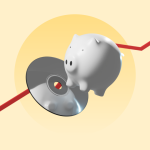The price of a gold bar is always in flux — because the price of gold is always in flux, literally changing every day the market is open. Gold fluctuates a lot over time, but it has a solid (gold) track record as a store of value, and tends to perform well during tough economic climates.
Here’s how much a gold bar is worth and the key factors to pay attention to.
How much are gold bars worth?
The price of a gold bar depends on two key factors: the size of the bar and the spot price of the shiny metal. As of July 24, the spot price is $2,397.50 per troy ounce. A troy ounce equals 1.097 standard ounces, or about 10 percent more, and it’s the standard measure for the weight of gold. A pound is equal to 16 standard ounces, so even a small amount of gold carries a lot of value.
From there you’ll need to determine just how large the gold bar is to determine its worth.
- The standard 400-troy ounce bar: This bar is the stuff you see in Hollywood films and it’s what central banks typically use in their own reserves. This bar weighs a stunning 27.4 pounds and is worth $959,000 at the recent spot price.
- The kilobar: This bar is a kilogram of gold, or 32.15 troy ounces. It prices out at about $77,080 at the recent spot price.
- The 100-troy-ounce bar: This gold bar is worth about $239,750 at recent prices.
Unlike cheaper metals such as silver and copper, a relatively small amount of gold can store a lot of value, making it especially ideal for investors who want to stash more of their cash.
Recently, retailer Costco made a splash when it began offering small gold bars for sale online. Its price was somewhat above spot prices at the time, part of the concern with owning bullion.
What is the best way to invest in gold?
The idea of owning one of those massive 400-ounce bars certainly has some novelty appeal, until you start to think about the cost of trading it. That’s because the spreads on physical gold and other metals could make used-car sales people blush — they’re utterly enormous. Gold dealers have to build in their own profit margins when they sell the bar to the next buyer.
Due to these costs, buying gold bullion is probably the absolute worst way to invest in gold.
Investors looking to buy gold will get clipped coming and going because of the spreads. When they go to buy gold, they’ll be forced to pay more than the spot price, meaning they’ve already lost money. Then when they go to sell, they’ll receive less than the fair value of the metal. An investor could easily lose 15 percent of the value just on the spread alone, and it could go higher.
But buyers of gold bullion also need to be aware of potential costs to secure physical gold. It’s not the kind of thing that you want to simply leave lying around, even if it is fun to trot out at a party to show your friends and impress your colleagues.
If you’re looking to invest in physical gold and want to minimize your costs, then it’s best to own an exchange-traded fund (ETF) that owns gold. The fund does all the heavy lifting — literally, in some cases — safeguarding the metal. Plus, when it comes time to buy or sell the fund, you’ll get fair market value for your gold without a commission at the best stock brokerages.
For these advantages, fund investors will pay an expense ratio based on their assets in the fund. For most funds, the expense ratio is at a reasonable level, and the expense is deducted daily.
But there may be still better ways to invest in gold, if you think it’s poised to rise. For example, it could make sense to invest in gold miners, which can appreciate not only when gold rises but also when they dig more of it out of the ground. This setup gives investors two ways to win.
Investors have several other ways to invest in gold that may offer more upside than buying physical gold.
Bottom line
The value of a gold bar depends on two key factors: the size of the bar and the always-moving price of gold. Because of its high price tag, a small amount of gold can hold a tremendous amount of value, making gold ideal for those looking to invest and trade in precious metals.
Read the full article here
















